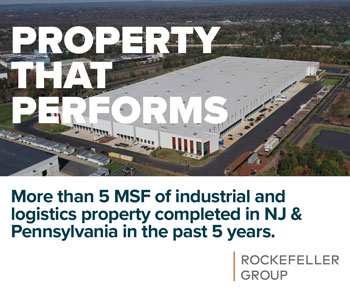By Michael G. McGuinness
Blueberries, tomatoes and peaches aren’t the only crops growing in the Garden State these days. Far removed from the fields of Hunterdon, Burlington and Salem counties are the leading-edge firms that are seeking older industrial type buildings, close to consumers, in which to grow baby salad greens, kale, other vegetables and even marijuana (medicinal, for now). These entrepreneurs will be competing for space with food e-retailers, which are already trending toward smaller (refrigerated) buildings that are located in denser urban areas closer to consumers. In a state where available industrial space is already in short supply due to our exploding e-commerce sector, asking prices and rents for older and smaller industrial buildings may soon be rising dramatically. Also on the rise will be demand for the power needed to fuel plant growth and maintain proper growing conditions.

AeroFarms, headquartered in Newark, where it also has a 70,000-square-foot grow facility, will soon be opening its 10th facility, in Camden, with a 78,000-square-foot indoor vertical farm. Its aeroponic technology grows crops without sun or soil and uses LED lighting and aeroponic mist to provide nutrients, water and oxygen to plant roots. The Newark facility has a ceiling height of 36 feet, which allows grow tables to be stacked 12 layers tall, each with their own lighting configuration. This system uses 95 percent less water than traditional field farming.
Similar emerging companies are likely to find their way into communities throughout the state. Government officials should look favorably on these types of uses (e.g., indoor vertical farming), as they help to achieve a number of public policy goals. Fostering job creation, reducing water consumption and enhancing public health by making fresh produce more accessible and affordable, plus teaching food literacy are ones that readily come to mind. These facilities may also help to build a sense of community, reduce crime and generate local revenues.
On the nonfood (marijuana) side, there are presently only four medical dispensaries in New Jersey, which also serve as grow facilities. On May 18 of this year, state Sen. Nicholas P. Scutari (D-22) introduced legislation (S3195) to legalize possession and use of small amounts of marijuana. With the majority of the gubernatorial candidates in favor of decriminalizing and/or legalizing its use, the odds are high that recreational marijuana will be legalized in New Jersey within the next two years. Enactment (and anticipation) of this law would be transformational and will likely further drive up rents for older industrial buildings in the 20,000- to 50,000-square-foot range with 15-foot or higher ceilings. Given that this type of activity is still a violation of federal law, the vast majority of buildings with debt would be off limits, since it is unlikely that lenders would finance a building with a type of tenancy deemed to be “criminal” at the federal level. Rent may have to be paid by cash or debit card.
Firms in the business of owning and/or operating cannabis grow facilities and dispensaries may be limited to buying their own buildings or building them from scratch. Siting these facilities will take considerable advance planning, due to the tremendous amount of power required to maintain continuous LED lighting, heating and cooling, dehumidification and humidification, and 24/7 monitoring of the premises to deter theft. Based on a review of existing marijuana grow facilities elsewhere, power demands are likely to be eight to nine times higher than a typical warehouse distribution center. For example, a 20,000-square-foot facility requires 2,000 AMP service. I suspect that a similar amount of power would be needed for any type of indoor farming. The implications of such power requirements are likely to be a long-term problem for any utility company and may require a lead time of one year or more. Costs could run into the millions of dollars, for which utility companies may have to back charge for infrastructure upgrades on the power system.
Aside from the tremendous amount of power required, these buildings also require a large water supply and floor drains and must be sealed or otherwise protected for microbial and odor control. Local zoning and prevailing NIMBY attitudes may lead to the siting of these facilities away from residential areas. This may make more sense, since placing grow facilities near a co-generation plant would provide access to cheaper power and heat energy. Together, with our state’s robust solar renewable energy program, this may lead to a boom in the development and use of solar arrays to generate power. Our new governor can be the champion for incentivizing our highly educated workforce and leading research universities to figure out the best way to roll out this emerging industry with the least adverse impact on our natural resources. The payoff could be substantial: Currently a $7 billion industry, cannabis is expected to be a $50 billion industry by 2026.
The potential effect on the commercial real estate industry may be a game-changing demand driver. In Massachusetts, which legalized recreational marijuana in December of last year, Austin Smith, senior vice president at Colliers International, recently reported that — based on Colorado’s experience from 2009 to 2014 — Boston could see 3.4 million square feet of absorption, which would send vacancies down by 3 percent. Rents would likely command a two to three times’ premium over market rates.
As with indoor food farms, there are a number of public policy objectives that can be achieved with legalizing adult use of cannabis. Scutari’s bill refers to things such as “eliminating problems caused by its unregulated distribution; diverting funds from illegal enterprises, gangs, and cartels; freeing up precious resources to allow our criminal justice system to focus on serious crime and public safety issues, keeping marijuana away from minors; and generating tax revenues to reinvest in New Jersey’s communities.” With the decline of adjacent farmlands, increasing fuel costs, the rise of nontraditional medicine and a populace that is more health conscious, indoor farming is here to stay. Those of us who develop, own, operate and invest in commercial and industrial real estate best start greening up our thumbs to stay ahead of the curve as we adjust to this new plant manufacturing industry.
Michael McGuinness is CEO of NAIOP New Jersey and has guided the commercial real estate development association’s progress since he joined the staff in 1997. In addition to overseeing daily operations, programs and staff, McGuinness directs the chapter’s legislative activities and manages the Developers Political Action Committee (DPAC).









